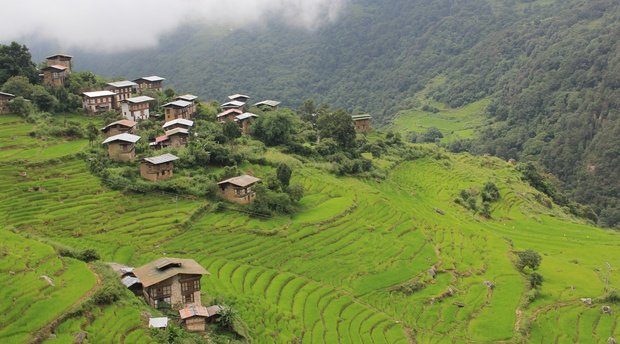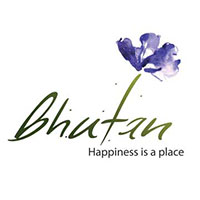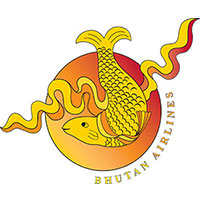Paro Tshechu is one of the most famous festivals in Bhutan. Many peopletravel from around the world and neighboring districts to participate in the festival. On the last day of the celebration, a gigantic Thangka (Thongdrel) of Guru Rinpoche will be displayed inside the Dzong. The Thongdrel will be displayed early in the morning and for a few hours only. It is believed that one can cleanse their own sins upon viewing the Thongdrel.

ARRIVAL IN PARO, BHUTAN
When you first arrive at Paro International Airport, you will be met by one of our delightful tour guides just outside the arrival hall.
We will drive to Thimphu and check into Hotel.
Thimphu is the capital of Bhutan and the perfect location to transition from your familiar lifestyle to our unique country that is like no other place on earth.
we will begin the tour with the National Memorial Chorten which was built in 1974 to memorialize Jigme Dorji Wangchuk, the third king of Bhutan (1928-1972). A chorten is a stupa, or hemispherical structure, that is used as a place of meditation. The whitewashed building with a golden finial on top is a popular location for prayer as it represents the strength and kindness of our beloved third king.
Thimphu Tashichho Dzong is a fortress and Buddhist monastery with a distinctive Bhutanese architectural design. Sitting aside the Wang Chhu (river), it is the current seat of the Druk Desi, the head of the civil government, and houses the offices of the current king.
On the weekends, Centenary Farmers’ Market is where farmers come to sell their vegetables, cheeses, grains, and the occasional yak leg. Across the street is the Kundeyling Baazam where you can check out local handicrafts, such as mala beads and prayer wheels. We will then take a scenic drive up to Buddha Point in the Kuenselphodrang to see the 169-foot-tall bronze statue of the seated Buddha Dordenma. One of the largest sitting Buddha statues in the world, it sits atop a hill where you will see sweeping views of the valley and surrounding mountains.
TOUR OF THIMPHU
After breakfast, our first stop will be at the National Folk Heritage Museum, dedicated to preserving Bhutanese folk arts. This renovated 19th-century building is laid out like a traditional, rural household which is three storied containing cultural relics, and artifacts. Demonstrations are performed throughout the day to show how the Bhutanese people have lived over the centuries.
Next we will visit Jungshi Handmade Paper Factory, you will see the ancient practice of natural papermaking. Using the bark of two local tree species (Daphne and Dhekap), craftsmen demonstrate how to make the traditional paper Deh-sho.
Weaving is considered the national art of Bhutan, so at The National Textile Museum, you will learn all about the brightly colored and beautifully designed fabrics that are worn by the Bhutanese people. Thanks in part to our Queen Jetsun Pema, the fabrics of Bhutan are widely considered high fashion around the world. Due to the importance of this living art form, the Royal Government of Bhutan works to preserve and promote these traditional weaving methods.
We will make a visit to Bhutan postal Office where one can get their own personalized stamp.
We will end the day with a visit to Simtokha Dzong. Built in 1629, it was the first fortress of its kind in Bhutan. Simtokha means “demon stone” and legend has it that the fortress was used to contain a demon inside a rock which was terrorizing the region. Today, it is home to one of the premier monk-taught Dzongkha learning centers, the national language of Bhutan.
THIMPHU TO PUNAKHA
Today we travel to Punakha, the former capital of Bhutan until 1955, and will stop at Dochula Pass along the way. This popular tourist spot provides stunning views of the Himalayas.
We will tour what is considered one of the most beautiful site in Bhutan, Punakha Dzong built in 1637sits at the fork of two rivers, it is a stunning example of Bhutanese architecture., it is the second oldest and second largest dzong in Bhutan.
We will hike to Khamsum Yully Namgyel Chorten which is around 45 mins one way hike.
It was built under the guidance of third Queen Mother Ashi Tshering Yangdon Wangchuck,and took nine years to complete as carpenters only used holy sculptures rather than modern engineering techniques and only accessible by foot.
PUNAKHA TO PARO
We will drive Punakha to Paro, which will take around 4 hours .
We will visit Rinpung Dzong,fortress of the heap of jewels.’ The dzong was built in 1644 by Zhabdrung Ngawang Namgyel on the foundation of a monastery built by Guru Rinpoche. Some of the scenes from the film ‘Little Buddha’ by Bernardo Bertolucci in 1995 was filmed at the Paro Rinpung Dzong.
We will also visitTa-Dzong (National Museum). Ta-Dzong was originally the watchtower for the Paro Dzong and stands imposingly on a hillock overlooking the Paro valley.
We stroll Paro town in the evening and check out souvenirs.
After early breakfast we will start today we will be heading to witness the Paro Tshechu.
In Tshechu, Bhutanese people can be seen wearing their best and colorful national dress making the already colorful festival even more colorful.
The Paro Tshechu, as all Tshechu festivals, honors Padma Sambhava, also known as Guru Rimpoche, the precious yogi and saint who is credited with having introduced Tantric Buddhism throughout the Himalayas. The festival’s masked dances are performed by monks clad in colorful brocade attire and permeated by chants and reading of Buddhist scripts. The culmination of festival constitutes the unfolding of a huge cloth thangka, a sacred scroll, depicting Padma Sambhava and imagery from Buddhist pantheon.
After Tshechu we will make a visit to Kyichu Lhakhang,one of the oldest temple in Bhutan. According to legend, a giant demoness lay her body across the Himalayas to prevent the spread of Buddhism. Tibetan King Songtsen Gambo built 108 temples throughout the region and around her body to pin her down, with Kyichu Lhakhang built to hold down her left foot.
In the evening we can try Hotstone bath in the Homestays which is good for joint pains and other diseases.
After early breakfast we will make a visit to Paro Tshechu to witness a gigantic Thangkha (Thongdrel) of Guru Rinpoche will be displayed inside the Dzong. The Thongdrel will be displayed early in the morning and for a few hours only. It is believed that one can cleanse their own sins upon viewing the Thongdrel
we will take a hike to Taktsang Monastery (or Tiger’s Nest), one of the most recognizable sites in Bhutan. Accessible only by foot, we will hike for couple of hours to reach the monastery . Built over the caves that Guru Padma Sambhava meditated in for three years, this eighth-century father of Bhutan Buddhism is said to have been brought there on the back of a tigress. It is one of the sacred sites in Bhutan and offers breathtaking views of the Paro valley.
DEPART PARO
Today we will bid fond farewell to this beautiful Himalayan country . And we look forward to seeing you again in this beautiful land of endless Enchantments!
Tashi Delek
-
What's Included?
- SDF and Visa fees
- Accommodations in minimum 3 star Hotel/Resort
- All meals (Breakfast, Lunch and Dinner) including evening tea/coffee etc through-out the tour in Bhutan.
- All land transfers, sightseeing with pick and drop to Paro airport
- Experienced English Speaking Bhutanese Tour Guide.
- Bottled water in the vehicle
- Tour SUV with well experienced driver
- Return souvenir gift from Bhutan
-
Not Included
- Flights into and out of Bhutan
- Museum/monument fees
- Personal expenses such as bars, beverages in the hotel, telephone, laundry, tips, and others.
- Hostone bath
- Archery cost and river rafting
- Travel Insurance (Recommended but not available in Bhutan)




